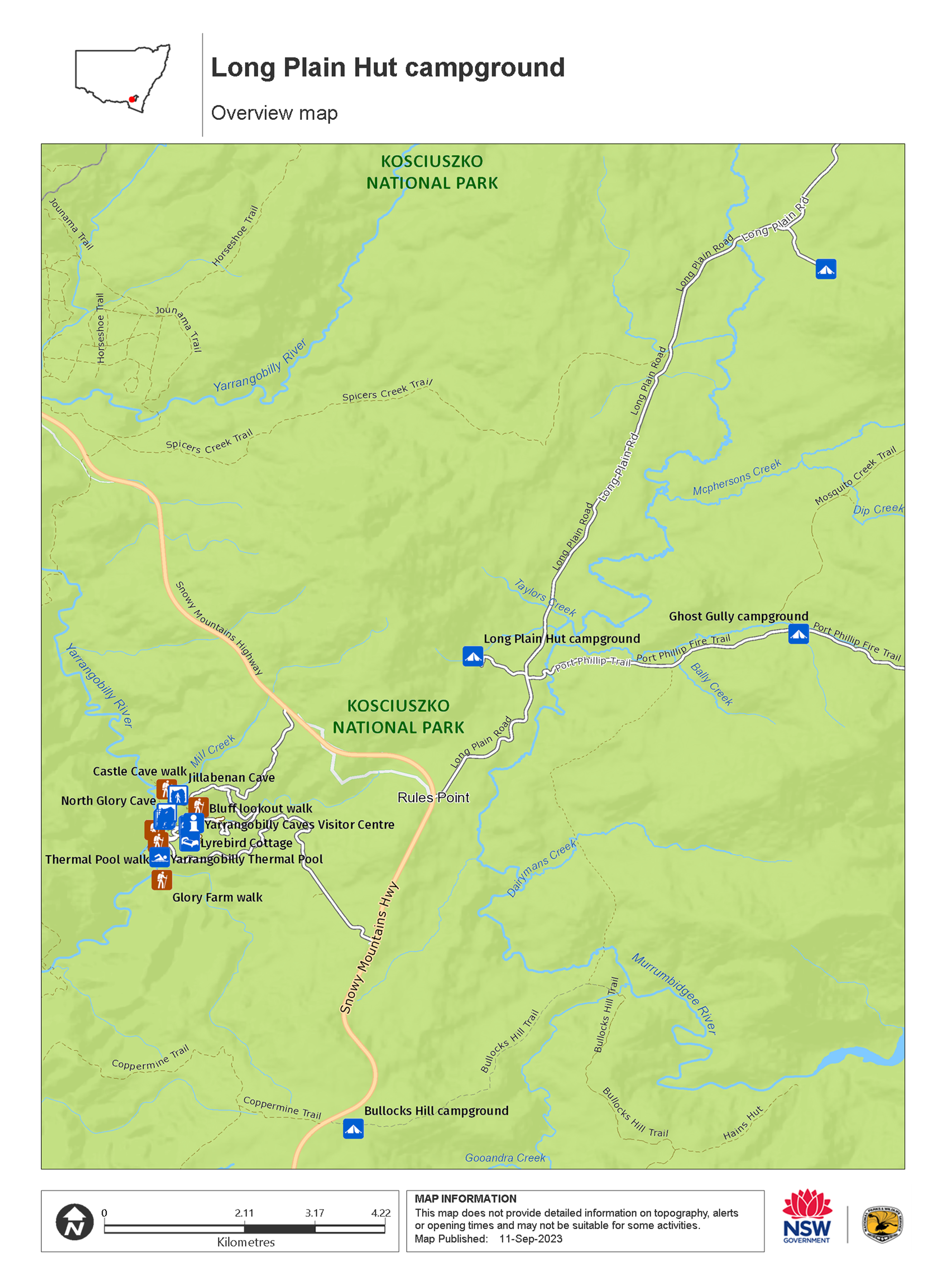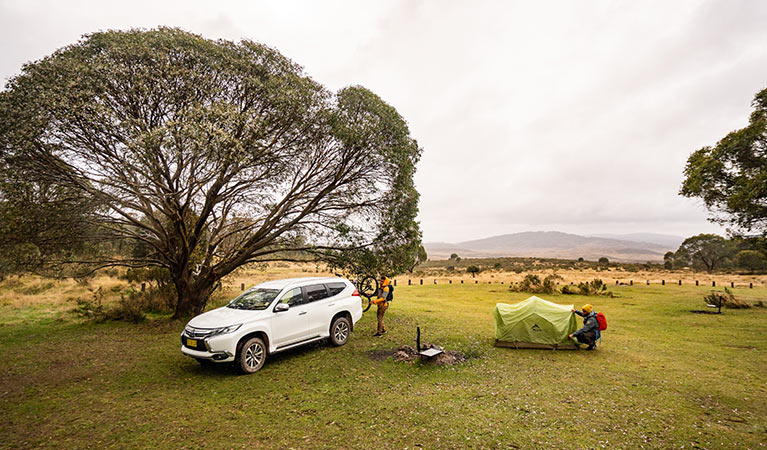Long Plain Hut campground
High Plains area in Kosciuszko National Park
Overview
Long Plain Hut campground is a great launch pad for mountain biking, hiking, fishing and horse riding adventures in the High Plains of northern Kosciuszko National Park.
| Camping type | Tent, Caravan site, Camper trailer site, Camping beside my vehicle , Camping with horses |
|---|---|
| Facilities | Toilets, unpowered sites, picnic tables, barbecue facilities |
| What to bring | Drinking water, cooking water, firewood |
| Opening times | Access roads to this campground are closed in winter (June to October long weekends). |
| Price | There are no camping fees at this campground but a $6 booking fee applies. |
| Group bookings | Book up to 20 people or 5 sites online. For larger groups, make a group booking enquiry. |
| Trip Intention Form |
Are you planning a bushwalk, going somewhere remote or where the weather is extreme? It's a good idea to let someone know where you're going. Fill in a trip intention form to send important details about your trip to your emergency contact. |
| Personal Locator Beacon |
Hire a Personal Locator Beacon (PLB) for free at Snowy Region Visitor Centre in Jindabyne, Perisher Valley Office, Tumut Visitor Centre or Khancoban Visitor Centre. |
| Please note |
|
Easily accessed from Cooma or Tumut via Snowy Mountains Highway, this free campground is a perfect base to explore northern Kosciuszko National Park.
Set up your caravan or pitch your tent with a view of historic Long Plain Hut, nestled among sub-alpine bushland dotted with snow gum and candlebark trees. Over 100 years old, the weatherboard hut is one of many historic alpine huts to discover in the high plains.
Breathe in the fresh mountain air and set out on one of the many walking tracks or mountain bike trails. With its own horse yards, the campground is also a great option if you want to camp with horses and discover this area’s trails on horseback.
Head further along Long Plain Road to Cooinbil Hut, and Coolamine Homestead. The high country heritage of Kiandra and natural wonders of Yarrangobilly Caves are a short drive away.
In spring, the heath and sod tussock grassland burst with wildflowers. It’s also the start of trout fishing season, so cast your line in the fresh, clear waters of high country streams, or the Murrumbidgee River and Tantangara Dam. If you’re lucky, you may catch a tasty dinner to barbecue as you relax back at your scenic campground.
Map

Map legend

Local alerts
For the latest updates on fires, closures and other alerts in this area, see https://www.nationalparks.nsw.gov.au/camping-and-accommodation/campgrounds/long-plain-hut-campground/local-alerts
Bookings
- National Parks Contact Centre
- 7am to 7pm daily
- 1300 072 757 (13000 PARKS) for the cost of a local call within Australia excluding mobiles
- parks.info@environment.nsw.gov.au
Operated by
- Tumut Region Visitor Centre
- 9am to 5pm daily. Closed Christmas Day.
- 02 6947 7025
- tumutrvc@environment.nsw.gov.au
- The Old Butter Factory, 5 Adelong Road, Tumut NSW 2720
Park info
- in the High Plains area of Kosciuszko National Park in the Snowy Mountains region
Long Plain Road and Tantangara Road (beyond the dam wall) are closed in winter from June to October long weekends. This period may be extended so it’s a good idea to contact the Tumut Visitor Centre. Areas may have to close at times due to poor weather or fire danger.
-
No park entry fees apply in the High Plains area. See vehicle entry fees for other areas in Kosciuszko National Park.
Buy annual pass.
Visitor info
All the practical information you need to know about Long Plain Hut campground.
Maps and downloads
Learn more
Long Plain Hut campground is in High Plains area. Here are just some of the reasons why this park is special:
Experiences and facilities

The vast grassland plains, with their hidden huts, are a superb backdrop for walking tracks, mountain bike trails and scenic drives. Blue Waterholes campground is a favourite summer destination to explore stunning walks, creeks, and gorges. There are plenty of campgrounds to choose from across the plains, and with horse riding popular here, many offer facilities for camping with horses. These include: Cooinbil Hut, Long Plain Hut, Ghost Gully, Old Snowy, Wares Yards, Rocky Plain, and Bullocks Hill campgrounds. You can also bring your horse if you’re staying at Currango Homestead, Daffodil Cottage or The Pines Cottage (fees and limits apply, bookings required).
Unique landscapes

As you explore the High Plains area you’ll see plains of snow grass, herbs and heath. Snow gums and black sallee eucalypts dominate the woodland, while mountain gum, candle bark and alpine ash also appear at higher elevations. The karst environment of the Cooleman Plain is best seen in the steep cliffs, narrow gorges, limestone caves and remarkable blue-tinged spring around Blue Waterholes.
- Clarke Gorge walking track The 5km Clarke Gorge walking track follows Cave Creek downstream through limestone gorges and cave formations. Stop along the way to do some fishing and birdwatching.
- Nichols Gorge walking track The 7km Nichols Gorge walking track, suitable for experienced hikers, follows Cave Creek and passes some karst features before rejoining Blue Waterholes trail.
- Snowy Mountains adventures with Cochran Horse Treks Join Cochran Horse Treks for an unforgettable adventure in Kosciuszko National Park. Their 3 to 7-day guided tours are a great way to experience stunning Snowy Mountains landscapes on horseback.
High country huts and heritage

From the mid-1800s into the 1950s, the high plains of Kosciuszko National Park attracted summer graziers who constructed timber and tin huts as shelter throughout the area. More than 20 of these photogenic high country huts are dotted along the many tracks and trails of the plains. Larger properties, like Currango or Coolamine Homesteads, became permanent residences and now provide a fascinating window into pioneer life.
A wonderland for wildlife

The complex karst environment of Cooleman Plain supports a rich community of animals and plants. Platypus, wombats, brushtail and ringtail possums, eastern grey kangaroos and red-necked wallabies are commonly seen along tracks and at campgrounds. The caves provide an important roosting site for the vulnerable eastern bentwing bat, and winter refuge for one of Australia’s highest populations of eastern water dragons. Keep an eye out for the leafy anchor plant along the banks of Cave Creek - it’s one of Australia’s only deciduous native plants.
- Clarke Gorge walking track The 5km Clarke Gorge walking track follows Cave Creek downstream through limestone gorges and cave formations. Stop along the way to do some fishing and birdwatching.
World-class wilderness

In recognition of Kosciuszko's unique value as a conservation area, it's been named a UNESCO Biosphere Reserve. More than half the area of the park, over 350,000ha, has been declared wilderness and includes the Goobarragandra, Bramina and Bimberi wilderness areas, which cover 61,500ha.
- Snowy Mountains adventures with Cochran Horse Treks Join Cochran Horse Treks for an unforgettable adventure in Kosciuszko National Park. Their 3 to 7-day guided tours are a great way to experience stunning Snowy Mountains landscapes on horseback.
- Snowy Mountains multi-day horse ride treks Immerse yourself in the wild beauty of the Snowy Mountains on a multi-day horse riding trek guided and supported by Reynella Rides. You'll enjoy hearty mountain food and roomy tents as you explore the High Plains area in Kosciuszko National Park.
Plants and animals protected in this park
Animals
-

Eastern bentwing-bat (Miniopterus schreibersii oceanensis)
Eastern bentwing-bats congregate in caves across the east and north-west coasts of Australia, in colonies of up to 150,000. These small Australian animals weigh around 13-17g and can reach speeds of up to 50km per hour. Eastern bentwing-bats use both sight and echolocation to catch small insects mid-air.
-

Swamp wallaby (Wallabia bicolor)
The swamp wallaby, also known as the black wallaby or black pademelon, lives in the dense understorey of rainforests, woodlands and dry sclerophyll forest along eastern Australia. This unique Australian macropod has a dark black-grey coat with a distinctive light-coloured cheek stripe.
-

Common ringtail possum (Pseudocheirus peregrinus)
Commonly found in forests, woodlands and leafy gardens across eastern NSW, the Australian ringtail possum is a tree-dwelling marsupial. With a powerful tail perfectly adapted to grasp objects, it forages in trees for eucalypt leaves, flowers and fruit.
-

Superb lyrebird (Menura novaehollandiae)
With a complex mimicking call and an elaborate courtship dance to match, the superb lyrebird is one of the most spectacular Australian animals. A bird watching must-see, the superb lyrebird can be found in rainforests and wet woodlands across eastern NSW and Victoria.
-

Eastern water dragon (Intellagama lesueurii lesueurii)
The eastern water dragon is a subaquatic lizard found in healthy waterways along eastern NSW, from Nowra to halfway up the Cape York Pensinsula. It’s believed to be one of the oldest of Australian reptiles, remaining virtually unchanged for over 20 million years.
-

Bare-nosed wombat (Vombatus ursinus)
A large, squat marsupial, the Australian bare-nosed wombat is a burrowing mammal found in coastal forests and mountain ranges across NSW and Victoria. The only other remaining species of wombat in NSW, the endangered southern hairy-nosed wombat, was considered extinct until relatively recently.
-

Yellow-tailed black cockatoo (Calyptorhynchus funereus)
The yellow-tailed black cockatoo is one of the largest species of parrot. With dusty-black plumage, they have a yellow tail and cheek patch. They’re easily spotted while bird watching, as they feed on seeds in native forests and pine plantations.
-

Platypus (Ornithorhynchus anatinus)
One of the most fascinating and unusual Australian animals, the duck-billed platypus, along with the echidna, are the only known monotremes, or egg-laying mammals, in existence. The platypus is generally found in permanent river systems and lakes in southern and eastern NSW and east and west of the Great Dividing Range.
-

Short-beaked echidna (Tachyglossus aculeatus)
One of only 2 egg-laying mammals in the world, the short-beaked echidna is one of the most widespread of Australian native animals. Covered in spines, or quills, they’re equipped with a keen sense of smell and a tube-like snout which they use to break apart termite mounds in search of ants.
-

Common brushtail possum (Trichosurus vulpecula)
One of the most widespread of Australian tree-dwelling marsupials, the common brushtail possum is found across most of NSW in woodlands, rainforests and urban areas. With strong claws, a prehensile tail and opposable digits, these native Australian animals are well-adapted for life amongst the trees.

